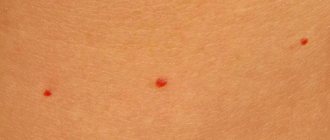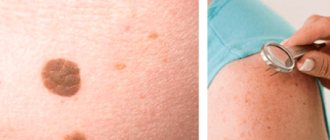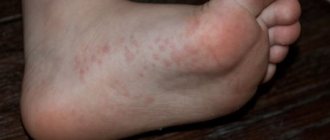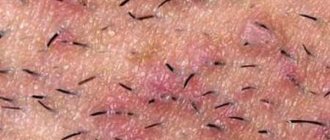Dermatovenerologist
Khasanova
Alina Rashidovna
9 years experience
Make an appointment
A mole is a benign formation that appears on the skin. Its key feature is pronounced pigmentation against the general background of the skin.
These pigments begin to appear at an early age. Children and adults have them. On the one hand, their presence does not cause any concern. On the other hand, moles from a benign formation can “grow” into a malignant one. Therefore, at the first signs of changes and severe symptoms, you should consult a specialist.
In professional medicine, a mole has another name - nevus. In general, this is not a strict medical concept; the word is used to unite various neoplasms that differ in nature.
Symptoms and signs of moles in adults
In medical practice, sometimes dangerous moles come across that need to be quickly removed. If this is not done, the disease will begin to progress, which can lead to quite unpleasant consequences. Therefore, it is extremely important to monitor the condition of pigmentation on the skin. Especially if you have large moles on your body or those that have begun to grow and visually change.
The symptoms of “bad” moles are as follows:
- moles of a different shape appear, symmetry is lost, the neoplasm grows in one direction;
- the edges become “torn”;
- Over time, the color changes and becomes uneven. This is the first sign that malignant moles are appearing on the body;
- quick resizing;
- change in texture - smooth moles become rough and vice versa;
- if there are hairs on the surface, their sudden loss should cause a person to worry;
- peeling, itching and burning in the place where the mole is.
Do you have any suspicious moles?
Only a doctor can accurately diagnose the disease. Don't delay your consultation - call
Briefly about the main thing:
You should not try to make a diagnosis yourself; this should still be done by an oncologist. On the other hand, it’s also not worth making a mountain out of nothing out of the blue.
If your mole does not have a single “bad” sign, but has several good ones, you should still see an oncologist. Calmly, without haste and fuss, as time permits.
The main point of this article is not for you to be able to understand for yourself whether a mole is malignant or not. My goal is to help you not go crazy because of the horror stories you have previously read on the Internet.
If doubts still overcome you, you can ask me any question in the format of an online consultation.
Causes
Why do moles appear on the skin? Every experienced mole doctor will say that there are several reasons for their appearance on the body:
- ultraviolet radiation;
- traumatic damage to the epidermis;
- systematic violation of the integrity of the skin;
- negative influence of radioactive background;
- Constant consumption of unhealthy foods, smoking, drinking alcoholic beverages. Because of this, moles on the body constantly grow;
- problems in the functioning of the endocrine system, changes in hormonal levels;
- hereditary predisposition.
Why moles appear
Why moles appear
A person observes the formation of moles on his body throughout his life. Often these formations appear completely unnoticed and are not a cause for concern. The reasons for the appearance of nevi are of different nature. When wondering why new moles appear, it is worth analyzing congenital and acquired factors.
- Hereditary nevi duplicate skin formations on the body of the closest relative. Their appearance is determined by the information contained in the genetic code of DNA.
- Pigment spots caused by exposure to ultraviolet radiation are the most dangerous and unpredictable in the dynamics of development.
- Injuries and negative environmental influences are also the strongest provocateurs of skin pigmentation. Doctors suggest that the appearance of moles on the body in some cases can be explained by insect bites, exposure to X-rays, some viruses, and radiation. Any factor that disrupts the balance of the body can trigger the process of concentration of melanocytes in a certain area with subsequent release to the surface of the skin.
- The aggressive behavior of melanin is facilitated by hormonal surges and hormonal imbalances in general. The largest number of nevi appear during adolescence, during pregnancy, in people with diseases of the adrenal glands, thyroid gland, and other endocrine diseases.
A person can have many moles on his body, but no two are ever alike. All differ from each other in shape, size, color. Each pigment formation has its own life cycle. So, in most cases, the first nevi appear at an early age, finally forming by 8-10 years. The appearance of age spots and their location directly depend on the concentration and location of melanocytes. The more there are, and the location closer to the surface of the skin, the darker and more voluminous the mole.
Why are nevi dangerous?
Most people live their lives with benign formations that never bother them and do not pose a threat to health. The appearance of new nevi is often accompanied by the disappearance of previously formed ones. A healthy body controls and regulates melanin production. And yet, pigmented spots, completely harmless and “calm” for many years, can be potentially dangerous. Over time, under the influence of various factors, they can degenerate into melanoma, a malignant tumor that develops from melanocytes.
Why do black moles appear?
The color of dermal formations depends on the concentration of melanin in them; The more it is, the darker the mole. However, you should not be afraid of intense staining. Darkening does not always indicate the development of oncological pathology. Each case is unique. But you shouldn’t leave any changes to a previously stable mole to chance. If black moles appear on the body, you should not postpone a visit to the doctor.
Complete or partial blackening of nevi is promoted by:
Ultra-violet rays.
Excessive exposure to the sun is a sure way to darkening of moles and the formation of new black growths. Moreover, you should not overuse tanning if you have many moles on your body. An increased concentration of melanin is a natural reaction of the body to potentially dangerous radiation.
Hormones.
Hormonal imbalances negatively affect the body as a whole and disrupt the functioning of individual organs and systems. Leather is no exception. Most moles appear on the human body during puberty, when taking hormonal drugs, in women - during pregnancy, after an abortion.
Mechanical damage.
Any actions aimed at frequent or periodic injury to nevi, in most cases lead to their darkening and increase the risk of degeneration.
Prevention of the occurrence and degeneration of moles
The appearance of moles is a largely uncontrollable process. However, you can prevent excess skin pigmentation if:
- Reduce exposure to the sun, especially during periods of increased activity;
- Dry your skin while sunbathing on the beach;
- Use high-quality sunscreens with SPF 30 or higher.
- Avoid injury to nevi;
- Lead a healthy lifestyle, get proper rest, eat a balanced diet, give up bad habits;
- Observe moles, and if you suspect degeneration, consult a doctor.
What moles should you get rid of?
The decision about the need to remove dermal formations should be made together with a qualified doctor. A specialist will diagnose the problem and offer the best solution. It is worth scheduling a visit to a dermatologist if you have moles on your body that are often injured or located in vulnerable places. It would not hurt to consult a specialist regarding formations that have the following characteristics:
- Asymmetry – changes in outline, uneven edges, uneven convexity;
- Uneven color - the mole began to darken, become engorged, and the skin pattern disappeared from the surface;
- Change in size - the larger the nevus, the more likely it is to degenerate. An increase in the size of a previously stable formation is a cause for concern;
- Discomfort - itching, pain, hair loss on the surface of the mole, peeling or wetting - alarming signals.
Skin tumors that appear in adulthood or form at the site of injury also require increased attention. Any suspicion of degeneration serves as a reason to make an appointment with a doctor. Early diagnosis increases the chances of successful treatment.
Ways to remove moles
Trying to get rid of education on your own, using folk remedies or following the advice of friends, can lead to disaster. Moles should be removed in specialized medical institutions, after consultation with a specialist in the field of dermatology or oncology and, if necessary, a comprehensive diagnosis.
There are several ways to remove moles:
Surgically
– resection is performed under anesthesia (local or general depending on the location of the formation, size, and individual wishes of the patient).
Cauterization - high or extremely low temperatures destroy cells, acting locally and virtually painlessly. In some cases, the procedure is performed under local anesthesia. Laser beam
is a progressive, highly effective method that eliminates relapses.
Laser mole removal is painless, quick, and safe. Radio waves
– a low-traumatic, non-contact method that involves exposing nevi to high-frequency radio waves.
Among the few contraindications to the procedure is the presence of a pacemaker in the patient. Medication
- there are many pharmaceutical products that can be used to remove moles, for example, Stefalin, Superchistotel and a number of others. However, this method is the most dangerous, and the result of exposure to ointments, gels or solutions is unpredictable.
Which removal method should I choose?
The laser method is the most effective and efficient way to get rid of moles available and practiced by modern medicine. The latest laser technologies, adopted by progressive clinics, make it possible to carry out the procedure as accurately as possible, targeting the skin formation.
The key benefits of laser mole removal are:
Painless.
The procedure can be performed without anesthesia.
At the request of the patient, it is permissible to use local anesthetics. Short rehabilitation period.
Cell regeneration after laser exposure occurs quickly.
A few days are enough for the skin to recover. A small scab at the site of the removed tumor disappears on its own after 5-7 days. Low morbidity.
The laser affects the skin formation very precisely, excluding damage to surrounding tissues.
High efficiency.
The appearance of a new mole in place of the removed one is excluded.
No scars.
Laser technology allows you to remove moles without leaving a trace.
No scars or stains are left. Bloodlessness.
Simultaneously with the removal of pathological cells, the laser seals the capillaries, preventing bleeding both during and after the procedure.
Efficiency
.
Removing one small mole takes literally a few seconds. In one session you can get rid of several nevi of different diameters and locations. Availability.
More and more clinics are mastering the popular, effective laser technique. The procedure can be completed by visiting a medical center or beauty salon that specializes in mole removal. At the Galaktika aesthetic medicine clinic (Moscow), nevi are removed using the latest equipment.
How is the procedure performed?
The laser technique does not exclude the possibility of histological examination of pathological cells after their removal, but tests that exclude malignancy of neoplasms must be done in advance. Based on the data obtained, the doctor recommends preparatory procedures to the patient. Immediately before resection, the mole is treated with an antiseptic and anesthetic. After removal, the affected area is cauterized to prevent infection and speed up the healing process.
You can learn more about methods for removing nevi and other skin growths at a consultation with a cosmetologist at the Galaktika aesthetic medicine clinic (Moscow).
When to see a doctor
There are the following types of moles:
- pigmented;
- vascular.
Usually, red moles on the body are harmless, but only if they have not changed color. If you find a mole, what should you do in this case? First, we advise you to carefully examine it. You need to go to the clinic with a mole if you have:
- bleeding or peeling;
- itching;
- dark areola or rim;
- rapid increase in size;
- sudden color change.
Types and classification
Moles have two main types:
- Pigmented. These include flat, often brown, nevi.
- Vascular, which are formed from changes in the structure of blood vessels.
They are also:
- Congenital - divided by size: small, medium and large.
- Acquired, divided into three types depending on the location of melanocytes in the layers of the epidermis.
- Hanging ones, they are also called papillomas.
There are invisible nevi that appear changing color over time. Also wandering, which change their location, appearing in one place or another. It is advisable to keep track of the location of your moles.
The second option for interpreting marks
There are several options for what birthmarks on the leg mean. The subtleties of explaining their meaning also depend on where exactly the mark is located.
Typically, a birthmark located on the leg indicates that its owner is a person with well-developed intuition, capable of subtly sensing future events. At the same time, such subtlety of nature is quite harmful. A person can be thrown out of balance by any irritating or stressful factor. Sometimes such irritation can last for quite a long time. While working, owners of such a birthmark pay a lot of attention to details and nuances rather than to the main subject.
Often, owners of such marks may suffer from strange dreams, the plot of which is quite incomprehensible and bizarre. They are strongly discouraged from overworking themselves and exhausting themselves to the limit. At the slightest sign of fatigue, you need to take a little time to allow your nervous system and body to rest. Types of employment such as dancing, light music, sports and spending time in nature have a beneficial effect.
People who have birthmarks on their legs may find their calling in the fields of surgery. They can also become good clergymen. But at the same time, these people can reach heights in the occult sciences, discovering and developing supernatural abilities in themselves.
The presence of a birthmark on the leg near the knees indicates that its owner is a person who does not know how and does not like to wait. They need to focus on learning to control themselves and control their nervousness. Quite often they are faced with the problem that they cannot complete the work they have started, being carried away by new ideas. To restore balance, long walks are perfect for them, as well as thinking about the details of the work they have started and imagining a positive final result.
A birthmark on a person’s lower leg indicates the lightness and mobility of his nature. Among such people, many achieve success in the sports field. A similar mark on a man indicates a large number of fans and the character of a monogamous man. The meaning of a birthmark on a woman’s leg in this area is a large amount of male attention without gossip and gossip behind the back due to the appearance of a touch-me-not.
If the mark of fate is located on the toes, then its owner is a vulnerable person who is overly concerned about the state of his health. Such people tend to suspect that they have many diseases. Amid this preoccupation, obsessions about illnesses and their progression may arise.
The influence of the shape and size of a birthmark on fate
Different mark shapes have different effects on a person's life path. Some forms of birthmarks meant difficulties and trials, while others indicated favor and protection from higher powers. A photo of a birthmark on your leg will help you more accurately determine its meaning and impact on your life.
To date, the following forms of nevi that affect fate have been identified:
- Cross.
- Bonfire with flames.
- Cat.
- Lip print.
- Star.
- Perfect circle.
A perfect circle shape is a good sign. While a more angular spot indicates the opposite. A round birthmark on the left leg indicates that quite good events await him. Also, such nevi are an indication that a person has well-developed intuition. The presence of supernatural powers in a person is indicated by a round birthmark on the right leg, located 30 cm above the knee bend, that is, close to the soft spot.
The presence of a cruciform birthmark is a symbol of the trials that higher powers send to a person. The nature of the tests depends on which part of the body it appeared on. A similar birthmark on the leg indicates that a person will often have to move from place to place.
The shape of the flame and bonfire is considered a symbol of temper. Such people do not know how to restrain their emotions. Men with such nevi suffer from excessive jealousy, and women are struck by the tendency to commit rash acts. Esotericists also note that people with such birthmarks are prone to prolonged and quite severe depression.
The star shape for birthmarks is considered the rarest in nature. However, a person who has such a spot on his body can be safely congratulated. It indicates that higher powers are favorable to him and grant him success in all his endeavors.
A birthmark in the shape of a cat indicates the secrecy and complexity of its owner’s character. At the same time, the color saturation of such a spot corresponds to the likelihood of the presence of mystical powers - the more saturated the color, the greater the likelihood of the manifestation of extrasensory abilities.
A birthmark, resembling a lip print in its shape, is a direct indication that fate has prepared a large number of surprises for its owner. Esotericists claim that men with a similar sign are very lucky, and it grants women protection from the evil eye and other negative magical influences.
Regarding the size of the mark, the interpretation is quite simple - the larger the birthmark, the stronger its influence. Based on this, we can say that a large birthmark on the leg will have a greater impact on a person’s life path than a small one on the neck or arm.
Do red moles need to be removed?
Not only is it possible, but it is also necessary. If the hemangioma increases in size, changes shape or color, this is, of course, a direct indication to see an oncologist as soon as possible for further examination, and removal if necessary. Of course, not using artisanal or folk methods, but with the help of modern specialists. If the mole behaves quite calmly and does not change shape or color, then most likely there is no need to be afraid and you can postpone removing the moles.
How are birthmarks and fate related?
In all eras, people have established a connection between birthmarks and the fate of a person. People perceived a birthmark on a leg or other part of the body as a sign indicating how a person’s fate would proceed and what his character would be. In this case, only those nevi that were more than 3 mm in diameter were taken into account. The size of the spot directly indicated how much influence the spot had on a person’s fate.
Also, when interpreting birthmarks as fateful signs, the following parameters were taken into account:
- Form.
- Size.
- Color.
- Presence of hair on the birthmark.
- Location.
Over time, the interpretations were supplemented, modified, and became more complete and capacious. This helped to more accurately reveal all the mystical influence that a birthmark in a certain place has on a person’s life, in particular, what a birthmark on the left leg means.
Reasons for appearance on the body
Light spots may appear in a newborn baby, but this is not a cause for concern. Most of these nevi disappear on their own. It is necessary to monitor the condition of the tumors and consult a doctor if there are changes. Dermatologists recommend tracking growth in a simple way: take a transparent file without color, attach it to the nevus, and trace the outline of the spot with a colored felt-tip pen. After 3 months, re-attach the file and compare the size.
The causes of white spots in adults depend on the condition that caused them. Pathology may be a consequence of impaired blood circulation, vitamin deficiency, or pregnancy. It may be temporary and go away on its own, sometimes requiring treatment.
Causes of white nevi in adults and children:
- genetic predisposition;
- diseases of the endocrine system;
- hormonal imbalance (pregnancy, adolescence);
- skin injuries;
- stress, nervous experiences;
- diseases of the gastrointestinal tract;
- metabolic disorder;
- abuse of bad habits;
- disruption of the movement of melanoblasts during intrauterine development;
A light mole can occur when a regular nevus discolors and disappears.
Types of pigmented moles
Another type of nevus is pigmented moles. They, in turn, are divided into the following types:
1. Lentigo. This is a solid color spot that can be either light or dark brown. Moles of this type are flat and do not protrude above the surface of the skin. Quite often they are mistaken for freckles.
2. Specific or complex nevi. They are distinguished by their dark color and convex structure. Their peculiarity is that they are located not only on the surface, but also on the inner layer of the epidermis.
3. Intradermal nevus. Has a smooth or rough surface. This mole is characterized by the appearance of hairs on its surface.
4. Sotton's spots. These age spots appear suddenly and also disappear unexpectedly. A significant difference between Sotton's spots and other types of moles is the specific halo that forms from discolored skin. Spots rarely degenerate into malignant neoplasms.
5. Blue moles. As the name implies, they are distinguished by their blue color, as well as their small size, reaching a maximum of 2 mm. All nevi are blue in color and have an even shape. Most often they appear on the face and neck.
6. Congenital nevi. They appear on the child’s body immediately after birth and grow with him.
Nevus formation
The basis of the mechanism of formation of pigment spots is a disruption in the functioning of melanoblasts. The latter are cells responsible for the production of the pigment melanin, which determines the color of the skin and individual areas of the skin on the body. Disruption of the functioning of melanoblasts can occur during the period of intrauterine development of the child.
As a consequence of pathological changes, melanin is distributed unevenly throughout the skin cells, which leads to the grouping of age spots in different areas of the skin. Doctors explain the formation of nevi as a genetically determined defect of the epidermis.
Contraindications
Hanging moles are not recommended to be removed in the following cases:
- Malignant neoplasms.
- Acute infectious and inflammatory processes in the body.
- Pregnancy and lactation period.
- A decrease in the body’s protective properties as a result of surgical interventions undergone in recent months.
- Skin damage in the area of intervention.
Mole removal is not recommended during menstruation and at high body temperature. If there are relative contraindications, the doctor will suggest postponing the procedure for a while until the body recovers and is ready for outside intervention.
Diagnostics
In medicine, there is a general method for diagnosing skin tumors. These include an initial examination and recording of all patient complaints (history). If a malignant tumor is suspected, an MRI or radiography is prescribed. All data obtained is analyzed and conclusions are drawn, on the basis of which a preliminary diagnosis is made. The main and final point in making a diagnosis is the histological method (biopsy). It is a microscopic sampling of tissue from the body of a mole, and is done to identify the pathology of cells in the neoplasm.
What does the color and hairiness of a birthmark indicate?
These two parameters indicate the nature of the impact that the stain has on its owner. There are some clarifications and specifications in the interpretation, but in general they can be interpreted in two ways - favorable and negative.
Light spots are considered favorable, namely:
- White.
- Straw ones.
- Yellowish.
- Reds.
- Light brown.
There is an opinion among esotericists that the darker the birthmark on the leg or other part of the body, the worse its influence on the fate and life path of a person. However, it is worth taking into account other factors that influence the meaning of birthmarks.
Regarding the hairiness of the birthmark, the interpretation is as follows. The more hair there is on a spot, the worse its effect. Hairless birthmarks can be very beneficial to a person's life if they are not influenced by other factors. A large length of hair on a spot has a negative impact on a person’s financial situation. Accordingly, the shorter the hair on the birthmark, the more material wealth a person achieves.
Risk group
First of all, this includes women - they develop similar neoplasms much more often than men. The cause of nevus is, as a rule, high levels of estrogen. The risk is also higher in people with very fair and sensitive skin. You should not spend long periods of time in the sun without high SPF protection. People with burns, both thermal and chemical, are also at risk.
Treatment at home
There are several methods for removing a nevus yourself. Special medications can be bought in pharmacies. They are drugs that have a freezing and necrotizing effect. In addition, you can use traditional medicine methods, namely:
1. Celandine. It is an affordable and effective means for removing moles. To do this, celandine juice is applied to the surface of the nevus twice a day. When a black dot forms at the application site, you should stop treatment and wait two weeks, during which the growth dries and falls off.
2. Soda. A paste of this product is applied to the mole for two weeks. Each time you need to wait until it dries and then wash it off. The procedure is repeated twice a day.
3. Garlic. Fresh juice should be used to treat the mole. It is necessary to avoid contact with healthy skin. For night compresses, you can use garlic soaked in vinegar for two weeks.
4. Iodine. This antiseptic also has a drying effect. Iodine can get rid of moles if applied twice a day.
Methods for removing red moles
If the mole does not bother you in any way and is not located in high-risk areas, that is, on the arms, feet, or head and back, then it is quite possible not to remove it.
If the hemangioma bothers you, then it can only be removed by specialists, a dermatologist or oncologist. You should not take the risk of removing a nevus from a cosmetologist and exposing the incorrectly removed hemangioma to the risk of growth or the risk of infection.
There are several common procedures for removing them.
- Electrocautery. The nevus is burned with an electric current delivered using a small instrument. The grounding block will be placed somewhere so that the rest of the body is not exposed to electricity.
- Cryosurgery. The mole is frozen using liquid nitrogen. It is destroyed by extreme cold. Liquid nitrogen is sprayed for 10 seconds, the problem is solved in one session. This method is quick and relatively simple. The wound also does not require special care.
- Laser surgery. This procedure uses a concentrated yellow laser beam that emits enough heat to destroy the nevus from the inside. This method is quick and is used on an outpatient basis, meaning it does not require subsequent hospitalization. Depending on how many moles will be removed, one to three procedures may be required. There may be small scars that will disappear within 10 days.
- Surgical method. This is the process of removing a nevus from the upper part of the skin by cutting the lesion and then applying sutures. It is not a frequently used method, and after such an intervention there are scars.
In any case, if you have concerns and questions about why red moles appear, you need to see a doctor, if only to reassure yourself with good tests. Because unexplained questions create stress, which in turn contributes to a decrease in immunity. Be healthy.
Birthmarks in the knee area
The main feature of the owners of a beautiful mole in the knee area, both on the outside and on the inside, is impatience. But the sign is positive, because it means that such a person will achieve success in all matters. He is not inclined to sit and wait, he prefers to be active.
At the same time, impatient haste can ruin the final result. Therefore, it is better to hurry wisely. Think through all the options for developing your plan to the end.
If the mark is on the right knee, for a man it means favorable creation of a family. The same thing awaits the woman who owns the same mark on her left knee. It is also a symbol of an athletic personality with good genes.
Nevus above the knee means two situations:
- For a man - high income, a prestigious position, his own business. All this is given by nature and will be successful if you behave correctly.
- For a woman, she has a strong nature and will dominate the family. However, she will be a good mother of good children. Sensitive, strict. A gift in pedagogy.
Esotericists often claim that nevi in the knee area come from past lives to those who were afraid of people a lot. Overcoming their fears becomes their main life lesson.
What is the difference between the interpretations of birthmarks in men and women?
In esotericism there is a statement that the side on which there is a birthmark is somewhat different for a man and a woman. This is due to the fact that different sexes have different sides of the body that are more favorable.
According to this statement, men are more positively influenced by a birthmark located on the right side of the body. At the same time, for women, the left side is more fortunate and decisive. However, despite this, exceptions to the rules are possible, and this principle does not always work so categorically and unambiguously.










